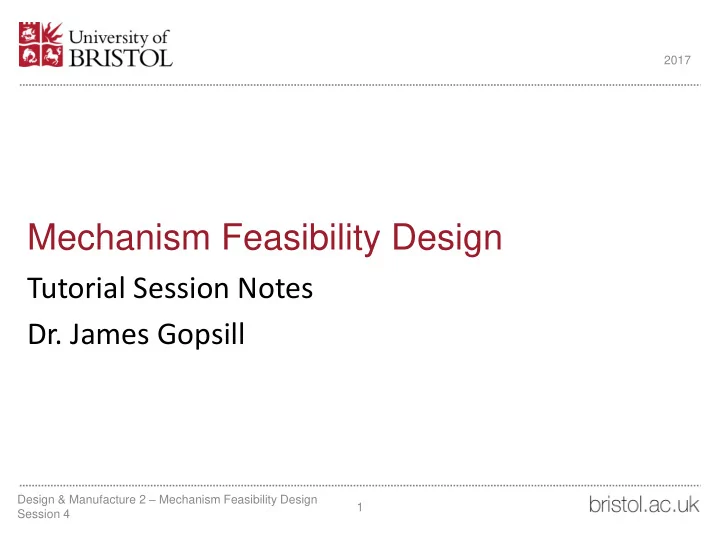

2017 Mechanism Feasibility Design Tutorial Session Notes Dr. James Gopsill Design & Manufacture 2 – Mechanism Feasibility Design 1 Session 4
2017 Last Week 1. Shaft Design Feedback 2. Deployment Modelling • Demo: Stopping the simulation at a specific point • Demo: Adding damping to a system • Demo: Four-bar mechanism 3. Building Your Deployment Model 4. Evaluating Motor & Gear Ratios Design & Manufacture 2 – Mechanism Feasibility Design 2 Session 4
2017 You should have done - Boundary Calculation What torque do you require to get the mechanism moving? 1. Assume a single mass 2. Calculate the centre of mass 𝑚 3. Torque required by the pivot to get 𝑛 this mass moving ∝ Design & Manufacture 2 – Mechanism Feasibility Design 3 Session 4
2017 You should have done - Boundary Calculation What motor and gear ratio is required to achieve this? • Select a motor from Bosch • Refer to your PDS when selecting the motor • Determine the gear ratio required • Note: you will need a gear ratio! • Record your rationale for your choice At the stage you’re only focused at selecting the motor and gear ratio that will get your mechanism moving! Design & Manufacture 2 – Mechanism Feasibility Design 4 Session 4
2017 Putting it in Simulink Now with a motor & gearbox selected . Focus on creating a simple pendulum using the values from your boundary calculation. Purpose: Focus on how you model and provide ? feedback from your motor and gearbox Design & Manufacture 2 – Mechanism Feasibility Design 5 Session 4
29 March 2017 Notes on the Motor • Not focusing on the control system • Imagine it switching on and running along the torque/speed line Design & Manufacture 2 – Mechanism Feasibility Design 6 Session 4
29 March 2017 Notes on the Motor • Not focusing on the control system • Imagine it switching on and running along the torque/speed line • The motor torque will vary through time because the t3 mechanism is being t2 t=0 t1 accelerated Design & Manufacture 2 – Mechanism Feasibility Design 7 Session 4
29 March 2017 Notes on the Motor ! • Not focusing on the control system • Imagine it switching on and running along the torque/speed line • The motor torque will vary through time because the t3 mechanism is being t2 t2 t1 T=0 accelerated • Want to maintain the motor ! within its operating window Design & Manufacture 2 – Mechanism Feasibility Design 8 Session 4
2017 Damping Linear Dampers Rotational Dampers Provide a smooth motion • Prevent people trapping their fingers • Safety if an element breaks • Motor over-speeding Design & Manufacture 2 – Mechanism Feasibility Design 9 Session 4
2017 Demo: Four-Bar Mechanism D (4) 30cm C (3) 80cm 80cm (2) B (1) 20cm E 80cm A Design & Manufacture 2 – Mechanism Feasibility Design 10 Session 4
2017 Demo: Four-Bar Mechanism Design & Manufacture 2 – Mechanism Feasibility Design 11 Session 4
2017 Building Your Mechanism Model 1. Build pendulum model powered by a motor & gearbox 2. Build a separate multi-bar mechanism of your model 3. Combine the two 4. Add damping to prevent the motor over-speeding • Otherwise place an IF statement to represent ‘disconnecting the motor’ from the mechanism at higher speeds Design & Manufacture 2 – Mechanism Feasibility Design 12 Session 4
2017 Why are we doing this again? • To investigate various motor and gearbox ratio combinations • Evaluate the energy required by the system to deploy • Determine the damping required to keep the motor within its operating window Design & Manufacture 2 – Mechanism Feasibility Design 13 Session 4
2017 This Week • Model the Pendulum with the Motor & Gearbox • Model of your mechanism • Combined Model • Evaluated a number of motor, gear ratios and levels of damping Design & Manufacture 2 – Mechanism Feasibility Design 14 Session 4
2017 This afternoons lecture – Gearbox Design 1. Types of Gear 2. Gear Definitions 3. Gear Forces 4. Multi-Stage Gearbox Example 5. Gearbox Design Report Section 6. This Weeks Task Design & Manufacture 2 – Mechanism Feasibility Design 15 Session 4
Recommend
More recommend